| |
 |
 |
| |
| El
Salvador |
| |
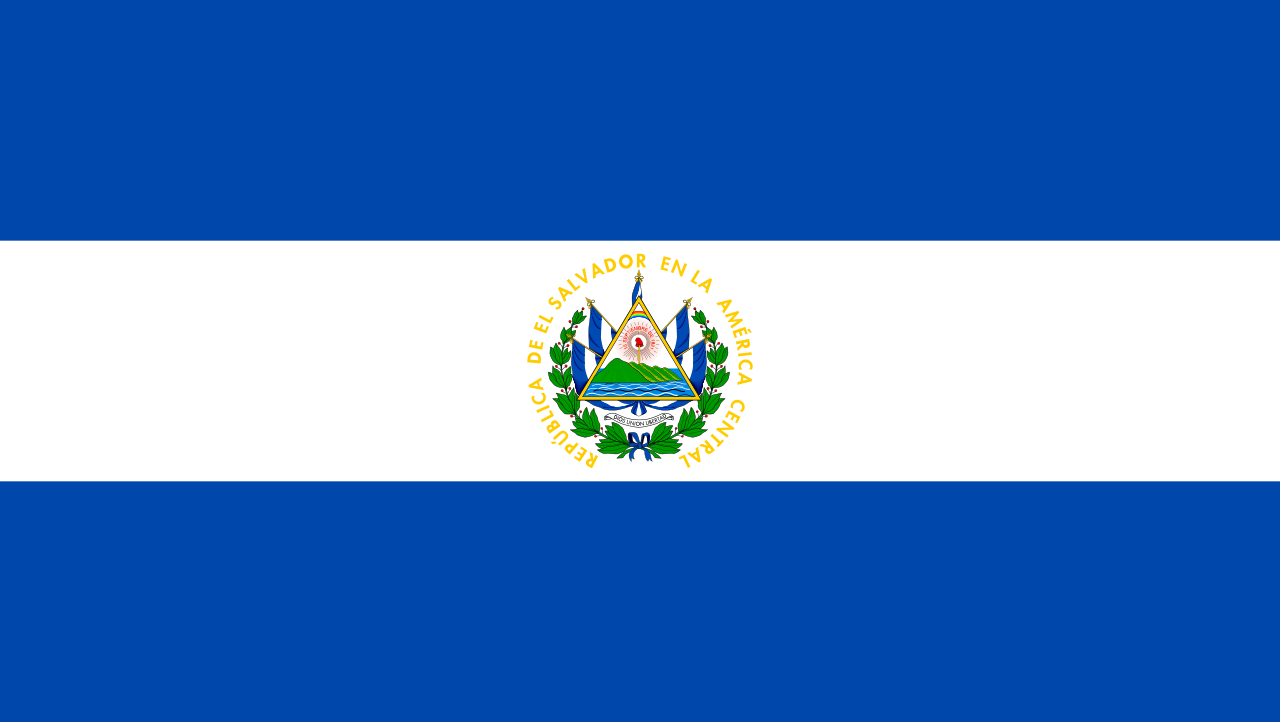 |
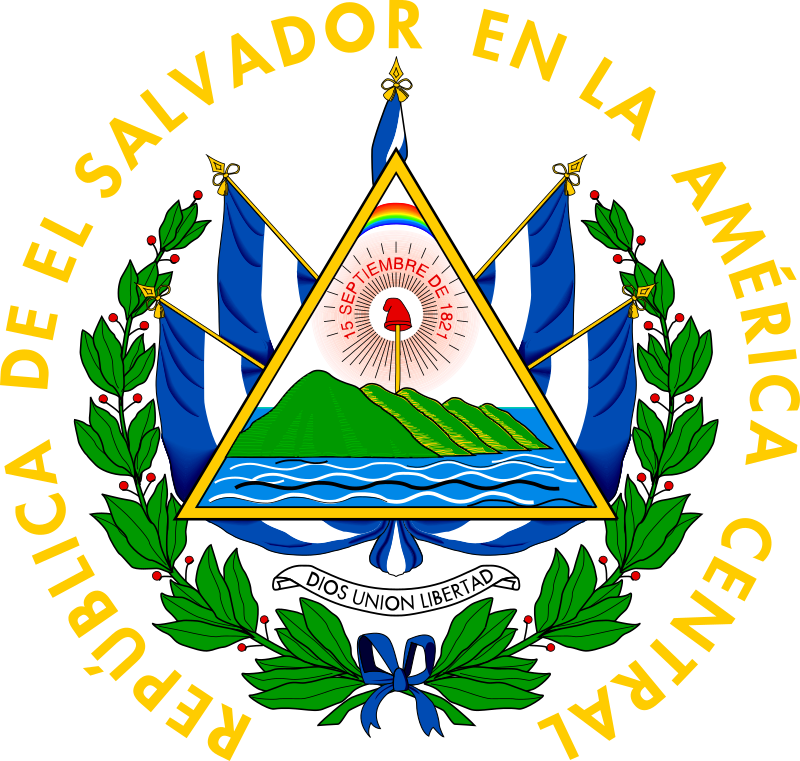 |
| |
El Salvador, officially the Republic
of El Salvador (Spanish: República de El Salvador, literally "Republic of
The Savior"), is the smallest and the most densely populated country in
Central America. It is bordered on the northeast by Honduras, on the
northwest by Guatemala, and on the south by the Pacific Ocean.
El Salvador's capital and largest city is San Salvador
(1528-1539: San Salvador en el Valle de la Bermuda; 1539-1579: San Salvador
en el Valle de las Hamacas). As of 2018, the country had a population of
approximately 6.42 million, mostly consisting of European and Native
American descent.
El Salvador was, for millenia, controlled by several Mesoamerican nations,
especially Lenca, early Mayans, then later the Cuzcatlecs up until the
Spanish conquest. Archaeological monuments also suggest an early Olmec
presence around the first millennium BCE. In the early 16th century, the
Spanish Empire conquered the territory, incorporating it into the
Viceroyalty of New Spain ruled from Mexico City. However the Viceroyalty of
Mexico had little to no influence in the daily affairs of the Central
American isthmus, which would be colonized in 1524. In 1609 the area became
the Captaincy General of Guatemala, of which El Salvador was part until its
independence from Spain, which took place in 1821, as part of the First
Mexican Empire, then later seceded, as part of the Federal Republic of
Central America, in 1823. When the Republic dissolved in 1841, El Salvador
became a sovereign nation, then formed a short-lived union with Honduras and
Nicaragua called the Greater Republic of Central America, which lasted from
1896 to 1898.
From the late 19th to the mid-20th century, El Salvador endured chronic
political and economic instability characterized by coups, revolts, and a
succession of authoritarian rulers. Persistent socioeconomic inequality and
civil unrest culminated in the devastating Salvadoran Civil War (1979–1992),
which was fought between the military-led government and a coalition of
left-wing guerrilla groups. The conflict ended with the Chapultepec Peace
Accords. This negotiated settlement established a multiparty constitutional
republic, which remains in place to this day.
El Salvador's economy has historically been dominated by agriculture,
beginning with the indigo plant (añil in Spanish), the most important crop
during the colonial period, and followed thereafter by coffee, which by the
early 20th century accounted for 90% of export earnings. El Salvador has
since reduced its dependence on coffee and embarked on diversifying its
economy by opening up trade and financial links and expanding the
manufacturing sector. The colón, the currency of El Salvador since 1892, was
replaced by the United States dollar in 2001.
El Salvador ranks 16th among Latin American countries in terms of the Human
Development Index and fourth in Central America (behind Panama, Costa Rica,
and Guatemala) due in part to ongoing rapid industrialization. However, the
country continues to struggle with high rates of poverty, inequality, and
gang-related violent crime. |
| Territorial
Disputes: International Court of Justice (ICJ) ruled on the
delimitation of "bolsones" (disputed areas) along the El Salvador-Honduras
boundary, in 1992, with final agreement by the parties in 2006 after an
Organization of American States (OAS) survey and a further ICJ ruling in
2003; the 1992 ICJ ruling advised a tripartite resolution to a maritime
boundary in the Gulf of Fonseca advocating Honduran access to the Pacific;
El Salvador continues to claim tiny Conejo Island, not identified in the ICJ
decision, off Honduras in the Gulf of Fonseca. |
| |
| |
| Chronology:
|
| |
1524 Spanish conquest beings (completed by 1540).
Apr 1525 San Salvador city founded (refounded 1528).
01 Apr 1528 Province of San Salvador (Provincia de San Salvador).
1538 - 1543
Governed by the Audiencia of Panama.
Nov 1542 Divided into three administrative districts
(Los Izalcos [from
1552 Sonsonate], Cuzcatlán,
and San Miguel); part of Kingdom of
Guatemala,
(which is subordinate to New Spain [Mexico]).
27 Sep 1546 San Salvador alcaldia formed from Cuzcatlán, Choluteca and
San Miguel.
1577 Alcaldía mayor de San Salvador.
17 Sep 1785 Intendancy of San Salvador (still subordinate to Guatemala).
05 Nov 1811 - 03 Dec 1811 Independence of San Salvador declared (not
recognized).
21 Sep 1821 Independence declared (Province of San Salvador,
constituent
of the Kingdom of Guatemala which declared its independence
15 Sep 1821).
11 Jan 1822 The province repudiates the decision by the Guatemala
junta
to incorporate the Kingdom of Guatemala into Mexico, and
declares its secession.
02 Dec 1822 Government requests annexation to United States.
10 Feb 1823 Incorporation into Mexico.
01 Jul 1823 Central America (the former Kingdom of Guatemala)
proclaims
its independence from Spain and Mexico; Province of San Salvador
is part of the newly established republic (under Guatemala).
22 Apr 1824 Constituent state of the Central American Republic
(State of Salvador) [Estado del Salvador].
Apr 1840 Federal authorities cease to exist.
02 Feb 1841 Secession by Salvador formally decreed.
Federal Republic of Central America dissolved.
Oct 1852 2nd attempt for Confederation with Honduras and Nicaragua as
Federation of Central America failed.
25 Jan 1859 Republic of Salvador (República del Salvador) [also in
sporadic official use since 07 Oct 1890, Republic of
El Salvador]. Republic of Salvador official use until
at least 1914.
15 Sep 1879 Text of National Anthem adopted.
(officially from 11 Dec 1953).
20 Jun 1895 Treaty of Amapala to have Confederation.
15 Jun 1866 Spain recognizes the independence of El Salvador.
15 Sep 1896 - 21 Nov 1898 3rd Confederation with Honduras and
Nicaragua as Greater Republic
of Central America (from 01 Nov 1898 Constitution was adopted
for abortive union as United States of Central America with
Capital: Amapala).
17 Sep 1896 State of Salvador (also Estado de El Salvador).
25 Nov 1898 Republic of El Salvador (República de El Salvador).
09 Jun 1915 Use of the form "El Salvador" as part of official
name of the
Republic is legally certified.
19 Jan 1921 El Salvador, Guatemala, Honduras and Costa Rica agreed to
formed
a (second) Federation of Central America at San José.
13 Jun 1921 - 04 Feb 1922 State of El Salvador (Estado de El
Salvador), during a later
aborted attempt at recreating a Central American Federation.
04 Feb 1922 Republic of El Salvador (República de El Salvador).
15 Oct 1979 – 16 Jan 1992 Salvadoran Civil War.
16 Jan 1992 The Chapultepec Peace Accords was signed by the combatants
in
Mexico City.
20 Dec 1983 Constitution. |
| |
| |
|
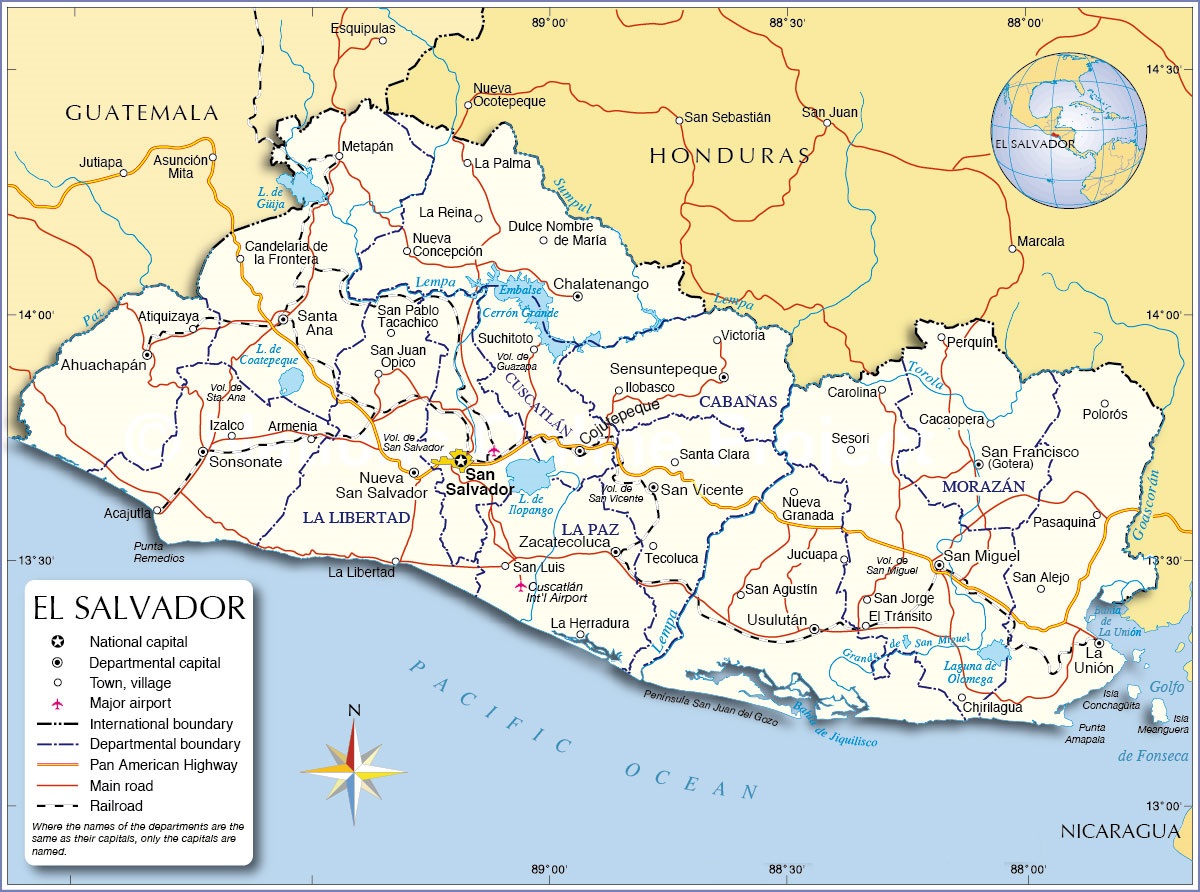 |
| |
| |
EL SALVADOR
- The smallest Central American state, located
next to Guatemala on the Pacific coast.
- CUZCATLAN
A pre-Columbian Nahuat nation of the Post-Classical period that extended
from the Paz river to the Lempa river (covering most of the western and
central zones of the present Republic of El Salvador).
- Cuachimicín
- Tutecotzimit
- Pilguanzimit
- Tonaltut
- Atlacatl....................................................
? - 1528
-
Spain.....................................................1521 - 21 Sep 1821
- Senior
justices (later Lieutenant governors)
- Gonzalo de
Alvarado y Contreras....................01 Apr 1525 - 1526 d. 1541
- Diego de Alvarado
Tordolla.........................01 Apr 1528 - 22 Apr 1529 d. 1540
- Gaspar Arias
Dávila................................22 Apr 1529 - Jul 1529
- Diego de
Rojas........................................Jul 1529 - 1530 d. 1544
- He was prisoner of Estete in 1530.
- Martín de Estete (Astete)........................................1530
d. 1536
- In dissidence, appointed by Pedro Arias Dávila
of Nicaragua.
- Luis de Moscoso
Alvarado..................................1530 - 1532 d. 1551
- Gómez de Alvarado
y Contreras.............................1532 - 1534 d. 1542
- Alcaldes
ordinarios of San Salvador
- Isidro Blasco.............................................1534
- 1536
- Alonso de Oliveros........................................1536
- 1537
- Pedro Cerón (1st
time) +
Antonio Docampo..................1537 - 1538
- Antonio Bermúdez..........................................1538
- 1539
- Luis Dubre................................................1539
- 1541
- Pedro Cerón (2nd
time) +
Antonio de Figueroa..............1541 - 1544
- Cristóbal Salvago
+ Juan de Ugarte........................1544 - 1548
- Luis de Dubois (1st
time).................................1548
- 1550
- Juan Vázquez de
Coronado y Anaya..........................1550 - 1552 d. 1565
- Gaspar de Cepeda..........................................1552
- 1554 d. 1558
- Ambrosio Méndez (1st
time)................................1554
- 1556
- Hernando Bermejo
+ Luis de Dubois (2nd
time)..............1556
- 1558
- Juan de
Tovar.............................................1558 - 1559
- Pedro
Benavides...........................................1559 - 1562
- Pedro Cerón (3rd
time)....................................1562
- 1564
- Juan Núñez de
Prado + Ambrosio Méndez (2nd
time)..........1564
- 1567
- Lope Pardo................................................1567
- 1569
- Luis Dubois (3rd
time)....................................1569
- 1570
- Hernando Bermejo..........................................1570
- 1572
- Gómez Díaz de la
Reguera + Blás Cordova...................1572 - 1573
- Luis Ganboa...............................................1573
- 1577
- Ignacio Cota..............................................1577
- 1579
- Alcaldes
Mayores of San Salvador
- Diego Galán (interim).....................................1579
- 1580
- Juan Cisneros de
Reynosa y Valverde (interim).............1580
- 1581
- Alonso de
Nava............................................1581 - 1586
- Alcaldes
Mayores of the Provinces of San Salvador, San Miguel and Jérez de la
Choluteca
- Lucas Pinto
Cuadrado......................................1585 - 1588 d. 1588
- Diego de Paz
(interim)....................................1588 - 1590
- Pedro Girón de
Alvarado (interim).........................1590
- 1593
- Luis de la Fuenta
y Cerda (interim).......................1593
- 1594
- Martín de Vega y Aceituno.................................1594
- 1596
- Francisco Osorio y Ávalos.................................1596
- 1602
- Alcaldes
Mayores of the Provinces of San Salvador and San Miguel
- Juan Guiral de
Mencis.....................................1602 - 1607
- Andrés Dorante de
Laguna..................................1607 - 1613
- Pedro Farfan de
los Godos (arrested
1619).................1613
- 1620
- Pedro de Aguilar
Lazo de la Vega..........................1620 - 1626
- He was also lieutenant of the captain-general.
- Pedro de Torres y
Toledo..................................1626 - 1631
- Eugenio de Nueda y
Góngora................................1631 - 1636
- Juan Sarmiento
Valderrama.................................1636 - 1641
- Martín de Duarte (interim)................................1641
- 1642 d. 1642
- Antonio Justiniano
Chavarri (interim).....................1642
- 1647
- Alcaldes
Mayores and Lieutenants of Captain-general of the Provinces of San
Salvador and San Miguel and (from 1689, San Vicente)
- Juan Martínez
Telles de los Ríos..........................1647 - 1652
- José Portal de
Artavia....................................1652 - 1657
- Francisco
Andrabeja.......................................1657 - 1659
- Lupercio de Espés
y Brizuela (interim)....................1659
- 1663
- Pedro de
Saravelles.......................................1663 - 1670
- Martín de Revollar........................................1670
- 1673
- Juan de
Miranda...........................................1673 - 1680
- Diego de Gamarra y
Balcárcel (interim)....................1680
- 1684
- Pedro Calvo del
Risco.....................................1684 - 1689
- José de Arría y
Hurtado...................................1689 - 1694
- José Calvo de
Lara........................................1694 - 1699
- Bartolomé Gálvez
Corral...................................1699 - 1703
- Juan Antonio Ruiz
de Bustamante (interim).................1703
- 1706 d. 1725
- Francisco Chacón
Medina y Salazar (interim)...............1706
- 1708 d. 1723
- Nicolás de Segovia
Parada y Verdugo.......................1708 - 1710
- Francisco
Rodríguez Franco (interim)......................1710
- 1715
- Andrés de
Miranda................................................1715
- He did not take office.
- Pedro de Oyanarte.........................................1715
- 1716 d. 1716
- Estebán de
Larramendi (interim)...........................1716
- 1718
- José Llanes
Robles........................................1718 - 1721
- Pedro de Doralea (interim)................................1721
- 1723 d. 1723
- Rodrigo Salgado (interim).................................1723
- 1724
- José de Algarrate................................................1724
d. 1724
- He did not take office.
- Pedro de Echevers.........................................1724
- 1729
- Antonio González
Manrique.................................1729 - 1734 d. 1738
- Cristóbal Marcos
de Gálvez Corral (1st
time).............1737
- 1737
- Manuel de Gálvez y
Corral (interim).......................1737
- 1740
- Esteban Sánchez
Calderón..................................1740 - 1744
- He did not come to San Salvador.
- Isidro Díaz de
Vivar......................................1744 - 1751
- Domingo Soto
Bermúdez.....................................1751 - 1756
- Manuel Amate (interim)....................................1756
- 1757
- Bernabé de la
Torre Trassierra (1st
time).................1757
- 1759 d. 1773
- Francisco Ignacio
Chamorro Sotomayor y Vilavicencio (interim)..1759
- 1761 d. 1785
- Manuel Fradique y
Goyena (1st
time - interim).............1761
- 1763
- José Jacinto
Palomo y Rodríguez (interim).................1763
- 1765
- Cristóbal Marcos
de Gálvez Corral (2nd
time)..............1765
- 1766
- Manuel Fradique y
Goyena (2nd
time).......................1766
- 1771
- Bernabé de la
Torre Trassierra (2nd
time).................1771
- 1773
- Rafael Benavides (interim).......................................1773
- He declined office.
- Francisco Antonio
de Aldana y Guevarra (interim)..........1773
- 1774
- Melchor de Meneos
(interim)...............................1774
- 1777
- Manuel Fradique y
Goyena (3rd
time).......................1777
- 1786
- Intendants
of San Salvador
- José Ortiz de la
Peña.....................................1786 - 1789
- Francisco Luis
Héctor de Carondelet de Novelles...........1786 - 1789 d. 1807
- He was also known
as Barón de Carondelet.
- José Antonio María
de Aguilar (interim)...................1791
- 1793 d. 1799
- Ignacio Santiago
Ulloa....................................1793 - 1798 d. 1798
- Antonio Isidoro
Palomo....................................1798 - 1805
- Bernardo José de
Arce (acting)............................1799
- 1800
- Luis Martínez
Navarrete (acting)..........................1800
- 1801
- Luis de Argueda (acting)..................................1801
- 1802
- José Justiniano
Ros (acting)..............................1802
- 1803
- Buenaventura de
Viteri (acting)...........................1803
- 1804
- Francisco Vallejo
(acting).......................................1804
- Antonio Basilio
Gutiérrez y Ulloa.........................1805 - 05 Nov 1811 d. af. 1831
- José Mariano
Batres y Asturias.....................05 Nov 1811 - 03 Dec 1811
- José Alejandro de
Aycinena y Carrillo (acting).....03
Dec 1811 - Aug 1812 d. 1826
- José María Peinado
(1st time).........................Aug
1812 - 1814 d. 1820
- José Méndez de
Quiroga....................................1814 - 1817
- Juan Miguel de
Bustamante.................................1817 - 1818
- Simón Gutiérrez..................................................1818
- José María Peinado
(2nd time).............................1818
- 29 Jan 1820
- Pedro Barriere de
la Barriere.............................1820 - 21 Sep 1821 d. 1827
|
-
Mexico.............................................21 Sep 1821 - 01 Jul
1823
- Intendant and Superior
Political Chief
- Pedro Barriere de la Barriere......................21
Sep 1821 - 28 Nov 1821
- Intendants and Governors
- José Matías Delgado y de León......................28
Nov 1821 - 09 Feb 1823 d. 1832
- From 11 Jan 1822, he became President of the
Junta of Government.
- Vicente Filisola...................................10
Feb 1823 - 07 May 1823 d. 1850
- Felipe Codallos Núñez..............................07
May 1823 - 25 May 1823
- Consultative Junta
- Mariano Prado
Baca.................................25 May 1823 - 17 Jun 1823 d. 1837
- José Milla.........................................25
May 1823 - 17 Jun 1823
- José
Rivas.........................................25 May 1823 - 17 Jun 1823
|
- Part of the
Republic of Central America............01 JUl 1823 - 02 Feb 1841
- Central American States: Capital: Guatemala
City (1821–1834) and then San Salvador (1834–1838).
- Supreme Political Chief
- Mariano Prado Baca (continued).....................01
Jul 1823 - 22 Apr 1824
- Chief of State
- Juan Manuel Rodríguez..............................22
Apr 1824 - 01 Oct 1824 d. 1847
- Supreme Chiefs of State
- Mariano Prado Baca (1st
time - acting).............01 Oct 1824 - 13 Dec 1824
- Juan Vicente Villacorta Díaz.......................13
Dec 1824 - 01 Nov 1826 d. 1828
- Mariano Prado Baca (2nd
time - acting).............01 Nov 1826 - 30 Jan 1829
- José María Cornejo Merino y
Guevara................30 Jan 1829 - 29 Mar 1832 d. 1864
- acting for Cornejo Merino
- José Damian Villacorta Cañas..................16
Feb 1830 - 25 Feb 1830 d. 1860
- José Francisco Morazán Quezada (1st
time)..........29 Mar 1832 - 13 May 1832 d. 1842
- He was Provisional Chief of State.
- Joaquín de San Martín y Ulloa (1st
time - acting)..13 May 1832 - 25 Ju1 1832 d. 1854
- Mariano Prado Baca (3rd
time)......................25 Ju1 1832 - 01 Jul 1833
- Anastasio Aquino (in
rebellion).......................Jan 1833 - 23 Apr 1833 d. 1833
- He was known as "king" of Nonualco indians.
- Joaquín de San Martín y Ulloa (2nd
time)...........01 Jul 1833 - 23 Jun 1834
- Carlos Salazar
Castro..............................23 Jun 1834 - 13 Jul 1834 d. 1867
- He was Provisional Chief of State; in
rebellion from 12 Jun 1834.
- Direct rule by
the Federal Government: 13 Jul 1834 - 30 Sep 1834.
- Joaquín Escolán y Balibrera (acting)...............30
Sep 1834 - 14 Oct 1834
- José María Silva (1st
time - acting)...............14 Oct 1834 - 10 Apr 1835 d. 1876
- Nicolás
Espinoza...................................10 Apr 1835 - 15 Nov 1835 d.
1845
- Francisco Gómez de Altamirano y de
Elizondo (acting)..15 Nov 1835 - 07 Mar
1836 d. 1838
- Diego Fernández Vigil y Cocaña.....................07
Mar 1836 - May 1838 d. 1845
- Timoteo Menendez (acting).............................May
1838 - 01 May 1839
- Antonio José Cañas Quintanilla (1st
time - acting).01 May 1839 - 13 Jul 1839 d. 1844
- José Francisco Morazán Quezada (2nd
time)..........13 Jul 1839 - 04 Apr 1840
- José María Silva (2nd
time - acting)...............04 Apr 1840 - 15 Apr 1840
- He departs / leaves the Country on 05 Apr
1840, therefore Municipal Council of San Salvador then assumes
government: 05 Apr 1840 - 15 Apr 1840.
- Municipal Council of San
Salvador
- Rafael Francisco Osejo (alcalde
de primer voto)....05 Apr 1840 - 15 Apr 1840 d. 1848
- Ignacio
Carrillo...................................05 Apr 1840 - 15 Apr 1840
- Isidro Viteri......................................05
Apr 1840 - 15 Apr 1840
- Supreme Chiefs of State
- Antonio José Cañas Quintanilla (2nd
time - acting).15 Apr 1840 - 23 Sep 1840
- Norberto Ramírez Áreas (acting)....................23
Sep 1840 - 07 Jan 1841 d. 1856
- Juan Nepomuceno Fernández Lindo y
Zelaya...........07 Jan 1841 - 22 Feb 1841 d. 1857
- He was Provisional Chief of State.
|
- Republic of El
Salvador............................02 Feb 1841 - 14 Dec 1948
- Presidents
- Juan Nepomuceno
Fernández Lindo y Zelaya...........22 Feb 1841 - 01 Feb 1842
- He was Provisional President.
- José Escolástico
Marín (acting)....................01
Feb 1842 - 14 Apr 1842 d. 1846
- Juan José Guzmán...................................14
Apr 1842 - 01 Feb 1844 d. 1947
- He was acting Provisional President to 20 Sep
1842.
- Fermín Palacios
Ulloa (1st time
- acting)..........01
Feb 1844 - 07 Feb 1844
- Francisco Malespín
Herrera.........................07 Feb 1844 - 15 Feb 1845 d. 1846
- Joaquín Eufrasio
Guzmán Ugalde Alvarado (1st
time).15 Feb
1845 - 01 Feb 1846 d. c. 1875
- In rebellion from 02 Feb 1845.
- Fermín Palacios
Ulloa (2nd time
- acting)..........01
Feb 1846 - 21 Feb 1846
- Eugenio Aguilar
González Batres....................21 Feb 1846 - 01 Feb 1848 d. 1879
- José Tomás Medina
Menéndez (acting)................01
Feb 1848 - 03 Feb 1848 d. 1884
- José Félix Quirós
Sánchez (1st
time - acting)......03
Feb 1848 - 07 Feb 1848 d. 1883
- Doroteo
Vasconcelos Vides y Ladrón de Guevara (1st)..07
Feb 1848 - 01 Feb 1850 d. 1883
- Ramón Rodríguez (acting)...........................01
Feb 1850 - 04 Feb 1850
- Doroteo
Vasconcelos Vides y Ladrón de Guevara (2nd)..04
Feb 1850 - 01 Mar 1851
- José Félix Quirós
Sánchez (2nd
time - acting)......01
Mar 1851 - 03 May 1851
- Francisco Javier
Dueñas Díaz (1st
time - acting)...03
May 1851 - 30 Jan 1852 d. 1884
- José María San
Martín y Fugón (1st
time - acting)..30
Jan 1852 - 01 Feb 1852 d. 1857
- Francisco Javier
Dueñas Díaz (2nd
time)............01
Feb 1852 - 01 Feb 1854
- Vicente Gómez (acting).............................01
Feb 1854 - 15 Feb 1854
- José María San
Martín y Fugón (2nd
time)...........15
Feb 1854 - 01 Feb 1856
- Francisco Javier
Dueñas Díaz (3rd
time - acting)...01
Feb 1856 - 12 Feb 1856
- Rafael Campo Pomar.................................12
Feb 1856 - 01 Feb 1858 d. 1890
- Lorenzo Zepeda (acting)............................01
Feb 1858 - 07 Feb 1858 d. 1859
- Miguel Santín del
Castillo y Barroeta..............07 Feb 1858 - 01 Feb 1860 d. 1880
- He was deposed de facto on 19 Jan 1859.
- Joaquín Eufrasio
Guzmán Ugalde Alvarado (2nd
act)..24 Jan
1859 - 15 Feb 1859
- José María Peralta
(acting)........................15
Feb 1859 - 12 Mar 1859 d. 1883
- José Gerardo
Barrios Espinoza......................12 Mar 1859 - 26 Oct 1863 d. 1865
- He was acting to 01 Feb 1860. He left national
territory on 19 Nov 1863.
- Francisco Javier
Dueñas Díaz (4th
time)............26
Oct 1863 - 15 Apr 1871
- He was Provisional President to 01 Feb 1865.
In rebellion: 10 Jul 1863 - 26 Oct 1863.
- Santiago González
Portillo.........................15 Apr 1871 - 01 Feb 1876 d. 1887
- He was Provisional President to 01 Feb 1872.
- Andrés del Valle
Rodríguez.........................01 Feb 1876 - 01 May 1876 d. 1888
- Rafael Zaldívar y
Lazo (1st time)..................01
May 1876 - 06 Apr 1884 d. 1903
- He was Provisional President: 01 May 1876 - 19
Jul 1876 and 02 Feb 1880 - 25 Feb 1880.
- Ángel Guirola......................................06
Apr 1884 - 21 Aug 1884 d. 1910
- He was Provisional President.
- Rafael Zaldívar y
Lazo (2nd time)..................21
Aug 1884 - 14 May 1885
- Fernando Figueroa
(1st time).......................14
May 1885 - 18 Jun 1885 d. 1919
- He was Provisional President.
- José Rosales
Herrador..............................18 Jun 1885 - 22 Jun 1885 d. 1891
- He was Provisional President.
- Francisco Menéndez
Valdivieso......................15 May 1885 - 22 Jun 1890 d. 1890
- In rebellion: 15 May 1885 - 22 Jun 1885.
Provisional President: 22 Jun 1885 - 01 Mar 1887.
- Carlos Basilio
Ezeta y de León.....................22 Jun 1890 - 09 Jun 1894 d. 1903
- He was Provisional President to 01 Mar 1891.
- Rafael Antonio
Gutiérrez...........................01 May 1894 - 13 Nov 1898 d. 1921
- In rebellion: 01 May 1894 - 10 Jun 1894.
Provisional President: 10 Jun 1894 - 01 Mar 1895. Governor: 01 Nov 1989
- 13 Nov 1898.
- Tomás Herculano de
Jesús Regalado Romero...........14 Nov 1898 - 01 Mar 1903 d. 1906
- Provisional President to 01 Mar 1899. The
union of United States of Central America was dissolved on 21 Nov 1898
after General Tomás Regalado seized power in El Salvador.
- Pedro José Escalón.................................01
Mar 1903 - 01 Mar 1907 d. 1923
- Fernando Figueroa
(2nd time).......................01
Mar 1907 - 01 Mar 1911
- Manuel Enrique
Araujo Rodríguez....................01 Mar 1911 - 09 Feb 1913 d. 1913
- Carlos Meléndez
Ramírez............................09 Feb 1913 - 01 Mar 1919 d. 1919
- He was Provisional President: 09 Feb 1913 - 29
Aug 1914.
- acting for absent Meléndez Ramírez
- Alfonso
Quiñónez Molina (1st
time)............29
Aug 1914 - 01 Mar 1915 d. 1950
- Alfonso
Quiñónez Molina (2nd
time)............21
Dec 1918 - 01 Mar 1919
- Jorge Meléndez
Ramírez.............................01 Mar 1919 - 01 Mar 1923 d. 1953
- Head of State: 13 Jun 1921 - 04 Feb 1922.
- Alfonso Quiñónez
Molina (3rd
time).................01
Mar 1923 - 01 Mar 1927
- Pío Romero Bosque
"Don Pío"........................01 Mar 1927 - 01 Mar 1931 d. 1935
- Arturo Araujo
Fujardo..............................01 Mar 1931 - 04 Dec 1931 d. 1967
- Maximiliano
Hernández Martínez.....................04 Dec 1931 - 09 May 1944 d. 1966
- acting Provisional President for absent
Hernández Martínez
- Andrés Ignacio
Menéndez (1st
time)............29
Aug 1934 - 01 Mar 1935 d. 1962
- Provisional
Presidents
- Andrés Ignacio
Menéndez (2nd
time).................09
May 1944 - 20 Oct 1944
- Osmín Aguirre y
Salinas............................21 Oct 1944 - 01 Mar 1945 d. 1977
- Miguel Tomás
Molina (in
rebellion).................04
Nov 1944 - 07 Nov 1944 d. 1965
- President
- Salvador Castaneda
Castro..........................01 Mar 1945 - 14 Dec 1948 d. 1965
|
- Military
Junta.....................................15 Dec 1948 - 14 Sep 1950
- Revolutionary Council of
Government
- Manuel de Jesús Córdova Rodríguez..................15
Dec 1948 - 05 Jan 1949
- Óscar Osorio Hernández.............................15
Dec 1948 - 22 Oct 1949 d. 1969
- Reynaldo Galindo
Pohl..............................15 Dec 1948 - 22 Oct 1949 d. 2012
- José Óscar Adán Bolaños
Estrada....................15 Dec 1948 - 14 Sep 1950
- Humberto
Costa.....................................15 Dec 1948 - 14 Sep 1950
-
Republic...........................................14 Sep 1950 - date
- Presidents
- Óscar Osorio
Hernández (continued).................14
Sep 1950 - 14 Sep 1956
- José María Lemus
López.............................14 Sep 1956 - 26 Oct 1960 d. 1993
- Junta of Government
(26 Oct 1960 - 25 Jan 1961)
- Miguel Ángel Castillo (Military)...................26
Oct 1960 - 25 Jan 1961
- Fabio Castillo
Figueroa............................26 Oct 1960 - 25 Jan 1961 d. 2012
- Ricardo Falla Cáceres..............................26
Oct 1960 - 25 Jan 1961 d. 1990
- René Fortín Magaña.................................26
Oct 1960 - 25 Jan 1961
- Rubén Alonso Rosales Soriano (Military)............26
Oct 1960 - 25 Jan 1961 d. 2000
- César Yanes Urías (Military).......................26
Oct 1960 - 25 Jan 1961
- Civic-Military Directory
(25 Jan 1961 - 25 Jan 1962)
- Aníbal Portillo Gonzalez (Military)................25
Jan 1961 - 25 Jan 1962 d. 2010
- Feliciano Avelar...................................25
Jan 1961 - 25 Jan 1962
- José Antonio Rodríguez Porth.......................25
Jan 1961 - 06 Apr 1961 d. 1989
- José Francisco Valiente............................25
Jan 1961 - 06 Apr 1961
- Julio Adalberto Rivera Carballo (Military).........25
Jan 1961 - 11 Sep 1961 d. 1973
- Mariano Castro Morán...............................11
Sep 1961 - 25 Jan 1962 d. 2005
- Provisional
President
- Eusebio Rodolfo
Cordón Cea.........................25 Jan 1962 - 01 Jul 1962 d. 1966
- Presidents
- Julio Adalberto
Rivera Carballo....................01 Jul 1962 - 01 Jul 1967
- Fidel Sánchez
Hernández............................01 Jul 1967 - 01 Jul 1972 d. 2003
- Arturo Armando
Molina Barraza......................01 Jul 1972 - 01 Jul 1977
- Carlos Humberto
Romero Mena........................01 Jul 1977 - 15 Oct 1979 d. 2017
- Revolutionary Junta
(15 Oct 1979 - 02 May 1982)
- Salvadoran Civil War: 15 Oct 1979 – 16 Jan
1992. A coup on 15 October 1979, was followed by killings of anti-coup
protesters by the government and of anti-disorder protesters by the
guerrillas, and is widely seen as the start of civil war. Main
Commanders from Farabundo Martí National Liberation Front (FMLN) were:
Schafik Jorge Handal, Joaquín Villalobos, Salvador Cayetano Carpio and
Salvador Sánchez Cerén. On 16 Jan 1992, The Chapultepec Peace Accords
was signed by the combatants at Chapultepec Castle in Mexico City. After
the ceasefire established, the FMLN converted itself from a guerrilla
army into a political party with Schafik Jorge Handal served as its
general coordinator. The FMLN has participated in elections since 1994.
Salvador Sánchez Cerén became El Salavador's President: 2014-2019.
- Adolfo Arnoldo Majano Ramos (Military).............15
Oct 1979 - 07 Dec 1980
- Jaime Abdul Gutiérrez Avendaño (Military)..........15
Oct 1979 - 22 Dec 1980 d. 2012
- Román Antonio Mayorga Quirós.......................17
Oct 1979 - 05 Jan 1980
- Guillermo Manuel Ungo Revelo.......................17
Oct 1979 - 05 Jan 1980 d. 1991
- Mario Antonio Andino Gómez.........................17
Oct 1979 - 05 Jan 1980 d. 2014
- José Antonio Morales
Ehrlich.......................09 Jan 1980 - 22 Dec 1980
- José Ramón Ávalos Navarrete........................09
Jan 1980 - 22 Dec 1980
- Héctor Miguel Antonio Dada Hirezi..................09
Jan 1980 - 03 Mar 1980
- José Napoleón Duarte
Fuentes.......................10 Mar 1980 - 22 Dec 1980 d. 1990
- President of the
Revolutionary Junta
- José Napoleón Duarte Fuentes (continued)...........22
Dec 1980 - 02 May 1982
- Provisional
President
- Álvaro Alfredo Magaña Borja........................02
May 1982 - 01 Jun 1984 d. 2001
- Presidents
- José Napoleón Duarte Fuentes (2nd
time)............01 Jun 1984 - 01 Jun 1989
- Alfredo Félix Cristiani Burkard....................01
Jun 1989 - 01 Jun 1994
- Armando Calderón
Sol...............................01 Jun 1994 - 01 Jun 1999 d. 2017
- Francisco Guillermo Flores Pérez...................01
Jun 1999 - 01 Jun 2004 d. 2016
- Elías Antonio Saca González........................01
Jun 2004 - 01 Jun 2009
- Carlos Mauricio Funes Cartagena....................01
Jun 2009 - 01 Jun 2014
- Salvador Sánchez Cerén.............................01
Jun 2014 - 01 Jun 2019
- Nayib Armando Bukele Ortez.........................01
Jun 2019 - date
|
| |
| |
|
Coinage |
| Currency:
Salvadoran Peso (SVC) = 8 Reales = 100 centavos [1847-1919] |
The peso replaced the Salvadoran and
Central American Republic reales, at a rate of 8 reales = 1 peso. Banknotes
were issued from 1877. In 1889, El Salvador decimalized, with the peso
subdivided into 100 centavos, and began to issue coins. The peso was
initially pegged to the French franc, at a rate of 1 peso = 5 francs. The
peso was replaced in 1919 by the colón, at par.
The first decimal Salvadoran coins were issued in 1889. These were
copper-nickel 1 and 3 centavos. On 28 August 1892, the Salvadoran mint was
established and production of silver and gold coins denominated in centavos
and pesos began. In addition to copper 1 centavo coins, there were silver 5,
10, 20 and centavos and 1 peso, and gold 2½, 5, 10 and 20 pesos, although
the gold coins were only issued in very small numbers (597, 558, 321, and
300 respectively. In 1909, bronze ¼ real coins were issued in response to
the continued use of the real currency system in parts of the country. Coins
for 25 centavos were introduced in 1911. Production of silver coins was
suspended in 1914. |
| |
|
1908 |
| |
|
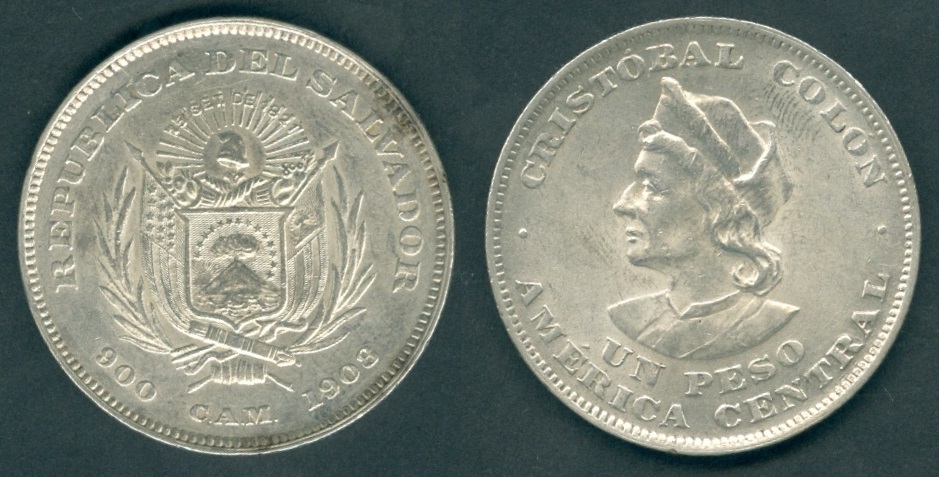 |
|
KM#115.1
25 centavos. Year:
1908. Weight:
24.94g [25.00 g]. Metal:
0.900 Silver.
Diameter:
37.00 mm. Edge:
Reeded. Alignment:
Coin. Mint:
San Francisco Mint, USA.
Obverse:
"REPUBLICA DEL SALVADOR" (Republic of
Salvador) written in Spanish at the top section.
National Coat and arms in the center. Fineness, Mint and Date "900
C.A.M. 1908" at the bottom section.
Reverse:
"CRISTÓBAL COLÓN"
(Christopher Columbus) written in Spanish at the top. Christopher
Columbus's portrait, facing left in the center with Value "UN PESO"
written below him. One dot each on left
and right sides. "AMÉRICA CENTRAL" (Central America) written at the
bottom. Mintage:
1,600,000.
Minted Years:
1892 C.A.M., 1893 C.A.M., 1893/2 C.A.M., 1894 C.A.M., 1895 C.A.M.,
1896 C.A.M., 1904 C.A.M., 1908 C.A.M. (San Francisco Mint), 1911
C.A.M. (Philadelphia Mint) and 1914 C.A.M. (Monnaie Royale de
Belgique).
Note: All coins bear the
C.A.M. (Central American Mint) mint mark, but they were minted in
different places as indicated above. KM#115.2 has Heavier portrait,
wider right shoulder. KM#115.2 were struck: 1904 C.A.M. (San Francisco Mint), 1909 C.A.M. (San Francisco
Mint), 1911 C.A.M. (San Francisco Mint) and 1914 C.A.M.
[Philadelphia Mint, including 20 pieces made in Proof]. |
|
| |
| |
| Currency:
Salvadoran Colón (SVC) = 100 centavos [11 September 1919 -31
December 2000]. |
The colón was the currency of El
Salvador between 1892 and 2001, until it was replaced by the U.S. dollar. It
was subdivided into 100 centavos and its ISO 4217 code was SVC. The plural
is "colones" in Spanish and the currency was named after Christopher
Columbus, known as Cristóbal Colón in Spanish.
The symbol for the colón is a c with two slashes. The symbol "₡" has Unicode
code point U+20A1, and the decimal representation is 8353. In HTML it can be
entered as ₡. The colón sign is not to be confused with the cent sign
(¢), which has a code point U+00A2 in Unicode (or 162 in decimal), or with
the cedi sign ₵, which has a code point U+20B5 in Unicode (or 8373 in
decimal). Nonetheless, the commonly available cent symbol '¢' is frequently
used locally to designate the colón in price markings and advertisements.
On October 1, 1892, the government of President Carlos Ezeta, decided that
the Salvadoran peso be called 'Colon', in homage to the "discoverer" of
America. The colón replaced the peso at par in 1919. It was initially pegged
to the U.S. dollar at a rate of 2 colones = 1 dollar. El Salvador left the
gold standard in 1931 and its value floated.
On 19 June 1934 the Central Bank was created as the government body
responsible for monetary policy and the sole body authorized to issue
currency in the nation. On January 1, 2001 under the government of President
Francisco Flores, the Law of Monetary Integration went into effect and
allowed the free circulation of U.S. dollar in the country (see
dollarization), with a fixed exchange rate of 8.75 colones. The colon has
not officially ceased to be legal tender.
Because the colón replaced the peso at par, 1 and 5 centavos coins issued
before 1919 and continued to be issued without design change after the
colón's introduction. In 1921, cupro-nickel 10 centavos were introduced,
followed by silver 25 centavos in 1943. In 1953, silver 50 centavos were
introduced alongside smaller silver 25 centavos. Both were replaced by
nickel coins in 1970. In 1974, nickel-brass 2 and 3 centavos coins were
introduced, followed by 1 colón coins in 1984. |
| |
|
1942 |
| |
|
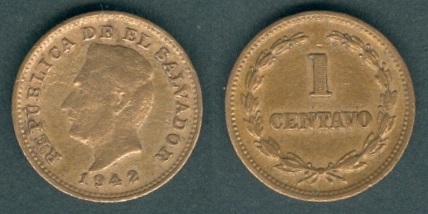 |
KM#135.1
Centavo. Year:
1942
(actually struck in 1943). Weight:
2.44g [2.50 g]. Metal:
Bronze.
Diameter:
16.00 mm. Edge:
Plain. Alignment:
Medal. Mint:
Philadelphia
Mint, USA. |
|
Obverse:
Francisco Morazán's head facing left in the
center. "REPÚBLICA DE EL
SALVADOR" (Republic of El Salvador) written in Spanish around
Francisco Morazán's
head. Date at the bottom.
Reverse:
Value "1 CENTAVO" in the center,
surrounded by
wreath on both sides with wreath knot at the bottom.
Mintage:
5,000,000.
Minted Years:
1942
(Philadelphia Mint; Struck in 1943),
1943
(San Francisco Mint; Struck in 1944),
1945
(Philadelphia Mint), 1947
(Philadelphia Mint), 1951
(San Francisco Mint), 1952
(San Francisco Mint; struck in 1953),
1956
(San Francisco Mint; struck in 1957),
1966
(San Francisco Mint), 1968
(San Francisco Mint), 1969
(Denver Mint)
and 1972
(San Francisco Mint).
Demonetized:
01 January 2001.
José Francisco
Morazán Quezada (born: 03 October 1792 – died: 15 September
1842) was a Central American politician who was president of the
Federal Republic of Central America from 1830 to 1839. He was born
in Tegucigalpa, Guatemala, New Spain (now in Honduras). Before he
was president of Central America he was the head of state of
Honduras. He rose to prominence at the battle of La Trinidad [es] on
11 November 1827. Morazán then dominated the political and military
scene of Central America until his execution in 1842.
-
Head of State of Honduras:
26 November 1827 - 30 June 1828, 02 December 1829 - 24 December
1829 and 22 April 1830 - 28 July 1830.
- 2nd
President of Central America:
16 September 1830 - 16 September 1834 and 14 February 1835 - 01
February 1839.
- Head of State of El Salvador:
29 Mar 1832 - 13 May 1832 and 13 Jul 1839 - 04 Apr 1840.
- Head of State of Costa Rica:
08 April 1842 - 11 September 11 1842 (de facto and later
deposed).
In the
political arena, Francisco Morazán was recognized as a visionary and
great thinker, as he attempted to transform Central America into one
large and progressive nation. He enacted liberal reforms in the new
Federal Republic of Central America, including freedom of the press,
freedom of speech and freedom of religion. Morazán also limited
church power by making marriage secular and abolishing
government-aided tithing.
These reforms made him some powerful enemies, and his period of rule
was marked by bitter infighting between liberals and conservatives.
But through his military skills, Morazán was able to keep a firm
grip on power until 1837, when the Federal Republic became
irrevocably fractured. This was exploited by the conservative
leaders, who rallied around the leadership of Rafael Carrera and in
order to protect their own interests, ended up dividing Central
America into five nations.
On 18 March 1840, Morazán made a last attempt to restore the
'Union'. He gathered what he thought were enough Salvadorean forces
to face Carrera, and with them marched to Guatemala. Morazán's
defeat was so decisive that on 27 March, he deposited the
headquarters of the State in the hands of director José Antonio
Canas and directed a proclamation to the people of El Salvador.
Morazán did not want to cause any more problems for the Salvadoreans.
With Francisco Morazán's final defeat, the hopes of a Central
American federation vanished.
On April 8, 1840, General Francisco Morazán went into exile. He left
from the port of La Libertad in El Salvador, and embarked on the
schooner Izalco accompanied by 30 of his closest friends and war
veterans. He stopped in Costa Rica where he sought and obtained
political asylum for most of his companions. Seven continued on the
journey to South America with him. Morazán landed at Chiriquí
Province, then moved on to David, Chiriquí where his family awaited
him. While in David, Morazán was informed by his friends of the
fierce persecutions suffered by his supporters at the hands of
Rafael Carrea and other Central American leaders. Outraged by this
and by the chain of insults and slander against him by some members
of the press, he wrote and published his famous 'Manifest of David'
dated 16 July 1841.
In Peru, Morazán was fortunate to find good friends with whom he
shared the same ideals. These included Generals José Rufino
Echenique and Pedro Bermudez. Around 1841, the English began to
intervene in the Mosquito territory, located between Honduras and
Nicaragua. This intervention prompted Morazán to end his
self-imposed Peruvian exile, and he decided that it was time to
return to Central America. With the financial backing of General
Pedro Bermudez, he departed from Callao on board the "Crusader" in
late December 1841. On that trip he was accompanied by General
Cabañas and Saravia, and five other officers. He and his companions
made stops in Guayaquil, Ecuador and Chiriqui where he met with his
family before returning to Central America.
On 15 January 1842, Morazán arrived in El Salvador. He made himself
available to the Central American leaders for the common defense
against the British intervention. On 16 February 1842, he told his
countrymen that his return was a "duty" and a "irresistible national
sentiment", not only for him but for all "those who have a heart for
their homeland." But his offers were rejected, nonetheless.
On 11 September 1842, a popular movement opposed to Morazán erupted
in San José, Costa Rica. Led by Portuguese General Antonio Pinto
Soares, 400 men attacked Morazán's guard of 40 Salvadoreans. Morazán
and his men managed to repel the attacks and retreat to their
headquarters. The fighting continued bloody and relentless, and the
insurgents increased to 1,000, while the number of the besieged
diminished. Chaplain José Castro then proposed a capitulation to
Morazán ensuring his life, but he refused. After 88 hours of
fighting, Morazán and his closest collaborators resolved to break
the siege. General José Cabañas with 30 men held the retreat, which
made it possible for the others to flee towards Cartago.
But the insurrection had spread there too, so Morazán turned for
help to his friend, Pedro Mayorga. But Mayorga betrayed him, and
turned him over to his enemies along with generals, Vicente
Villaseñor, José Saravia and José Trinidad Cabañas. Saravia
committed suicide, Villaseñor attempted the same but survived.
Subsequently, Morazán and Vicente Villaseñor were sentenced to
death. On 15 September, Morazán and Villaseñor were transferred to
the central plaza in San José.
Before his execution, Morazán dictated his famous will to his son,
Francisco. In it, he calls his death "murder" and declares, "I do
not have enemies, nor the smaller resentment I take to the grave
against my murderers, I forgive them and wish them the greatest
good." When he was done, a chair was offered to him but he refused
it. Seated next to him was Gen. Villaseñor, sedated and almost
unconscious. Morazán then said, "Dear friend, posterity will do us
justice" and crossed himself. A few minutes later, Morazán himself
commanded the firing squad that ended his life and that of
Villaseñor.
With his death, the nation lost a man described by José Martí as "a
powerful genius, a strategist, a speaker, a true statesman, perhaps
the only one Central America has ever produced". In 1848, the
government of José María Castro sent Morazán's remains to El
Salvador, fulfilling one of his last wishes. |
|
| |
|
1944 |
| |
|
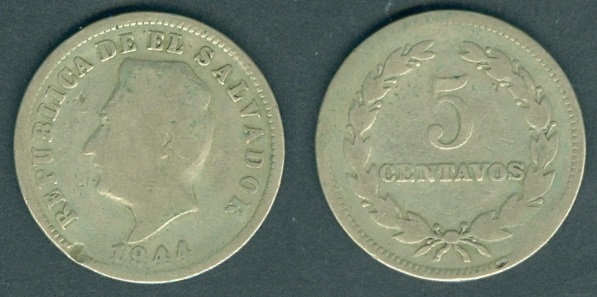 |
KM#134a
5
Centavos. Year:
1944. Weight:
4.62g [5.00 g]. Metal:
Nickel-Silver [German Silver = 70% Copper, 18%
Zinc and 12% Nickel].
Diameter:
23.00 mm. Edge:
Plain. Alignment:
Medal. Mint:
San Francisco Mint, USA. |
|
Obverse:
Francisco Morazán's head facing left in the
center. "REPÚBLICA DE EL
SALVADOR" (Republic of El Salvador) written in Spanish around
Francisco Morazán's
head. Date at the bottom.
Reverse:
Value "5 CENTAVOS" in the center,
surrounded by
wreath on both sides with wreath knot at the bottom.
Mintage:
5,000,000.
Minted Years:
1944
(San Francisco Mint), 1948
(San Francisco Mint), 1950
(San Francisco Mint)
and 1952
(San Francisco Mint; half were minted in 1952, the other half
in 1953).
Demonetized:
01 January 2001. |
|
| |
|
1948 |
| |
|
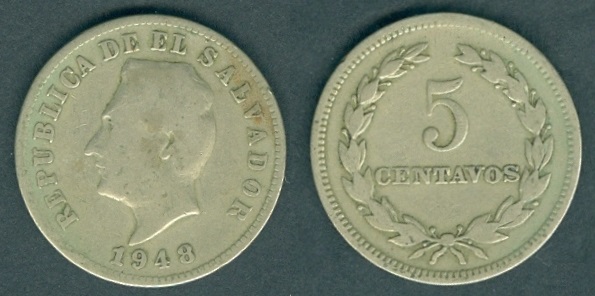 |
Same as above KM#134a
5
Centavos,
but...
Year: 1948.
Weight: 4.79 g
[5.00g].
Mint:
San Francisco Mint, USA. Mintage:
3,000,000. |
|
| |
|
1952 |
| |
|
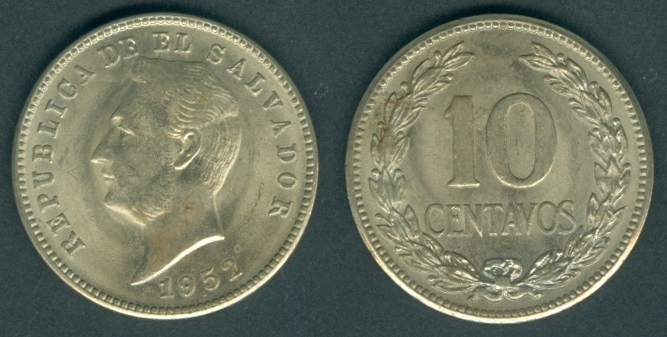 |
KM#130a
10
Centavos. Year:
1952. Weight:
7.01g [7.10 g]. Metal:
Zinc clad Copper-Nickel.
Diameter:
26.00 mm. Edge:
Plain. Alignment:
Medal. Mint:
San Francisco Mint, USA. |
|
Obverse:
Francisco Morazán's head facing left in the
center. "REPÚBLICA DE EL
SALVADOR" (Republic of El Salvador) written in Spanish around
Francisco Morazán's
head. Date at the bottom.
Reverse:
Value "10 CENTAVOS" in the center,
surrounded by
wreath on both sides with wreath knot at the bottom.
Mintage:
2,000,000 (1,664,000 were actually struck in
1953).
Minted Years:
1952
(San Francisco Mint) and 1985
(Mexico City Mint).
Demonetized:
01 January 2001. |
|
| |
|
1953 |
| |
|
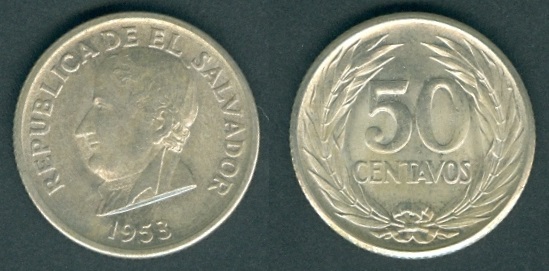 |
KM#138
50
Centavos. Year:
1953. Weight:
5.04g [5.00 g]. Metal:
0.900 Silver.
Diameter:
21.00 mm. Edge:
Reeded. Alignment:
Coin. Mint:
San Francisco Mint, USA. |
|
Obverse:
Francisco Morazán's head facing left in the
center. "REPÚBLICA DE EL
SALVADOR" (Republic of El Salvador) written in Spanish around
Francisco Morazán's
head. Date at the bottom.
Reverse:
Value "50 CENTAVOS" in the center,
surrounded by
wreath on both sides with wreath knot at the bottom.
Mintage:
3,000,000.
Minted Years:
One year type.
Demonetized:
01 January 2001. |
|
| |
|
1956 |
| |
|
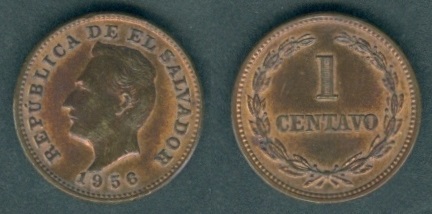 |
Same as above KM#135.1
Centavo,
but...
Year: 1956 (actually
struck in 1957).
Weight: 2.50 g
[2.50g].
Mint:
San Francisco Mint, USA. Mintage:
10,000,000. |
|
| |
|
1967 |
| |
|
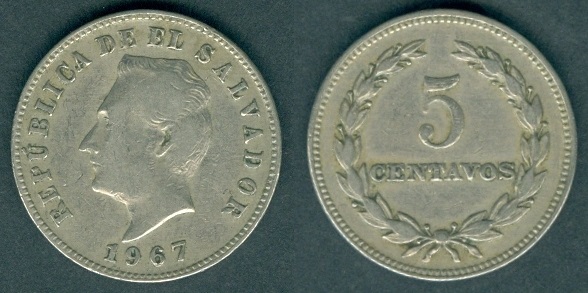 |
KM#134
5
Centavos. Year:
1944. Weight:
4.83g [5.00 g]. Metal:
Copper-Nickel.
Diameter:
23.00 mm. Edge:
Plain. Alignment:
Medal. Mint:
San Francisco Mint, USA. |
|
Obverse:
Francisco Morazán's head facing left in the
center. "REPÚBLICA DE EL
SALVADOR" (Republic of El Salvador) written in Spanish around
Francisco Morazán's
head. Date at the bottom.
Reverse:
Value "5 CENTAVOS" in the center,
surrounded by
wreath on both sides with wreath knot at the bottom.
Mintage:
10,000,000.
Minted Years:
1939
(Philadelphia Mint), 1940
(Philadelphia Mint), 1944
(San Francisco Mint), 1951 (San
Francisco Mint), 1956
(Philadelphia Mint), 1959
(Philadelphia Mint), 1963
(Philadelphia Mint), 1966
(San Francisco Mint), 1967
(San Francisco Mint), 1972
(San Francisco Mint)
and 1974
(Sherrit Mint).
Demonetized:
01 January 2001. |
|
| |
|
1968 |
| |
|
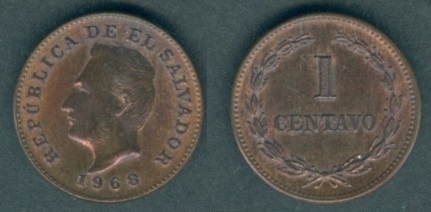 |
Same as above KM#135.1
Centavo,
but...
Year: 1968.
Weight: 2.50 g
[2.50g].
Mint:
San Francisco Mint, USA. Mintage:
5,000,000. |
|
| |
|
1969 |
| |
|
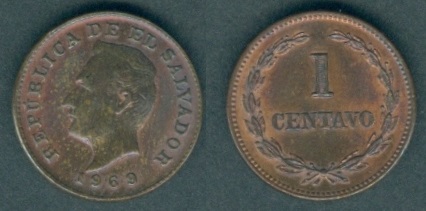 |
Same as above KM#135.1
Centavo,
but...
Year: 1969.
Weight: 2.42 g
[2.50g].
Mint: Denver Mint,
USA. Mintage:
5,000,000. |
|
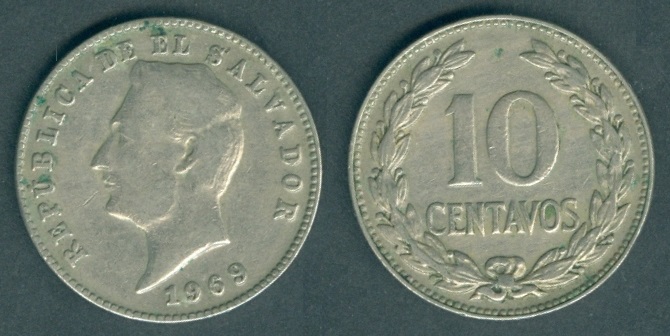 |
KM#130
10
Centavos. Year:
1969. Weight:
7.10g [7.10 g]. Metal:
Copper-Nickel.
Diameter:
26.00 mm. Edge:
Plain. Alignment:
Medal. Mint:
Denver Mint, USA. |
|
Obverse:
Francisco Morazán's head facing left in the
center. "REPÚBLICA DE EL
SALVADOR" (Republic of El Salvador) written in Spanish around
Francisco Morazán's
head. Date at the bottom.
Reverse:
Value "10 CENTAVOS" in the center,
surrounded by
wreath on both sides with wreath knot at the bottom.
Mintage:
3,000,000.
Minted Years:
1921
(San Francisco Mint), 1925
(San Francisco Mint), 1940
(San Francisco Mint), 1951
(San Francisco Mint), 1967
(San Francisco Mint), 1968
(Denver Mint), 1969
(Denver Mint)
and 1972
(San Francisco Mint).
Demonetized:
01 January 2001. |
|
| |
|
1972 |
| |
|
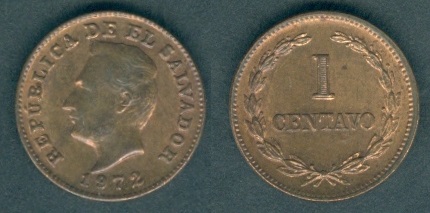 |
Same as above KM#135.1
Centavo,
but...
Year: 1972.
Weight: 2.46 g
[2.50g].
Mint:
San Francisco Mint, USA. Mintage:
20,000,000. |
|
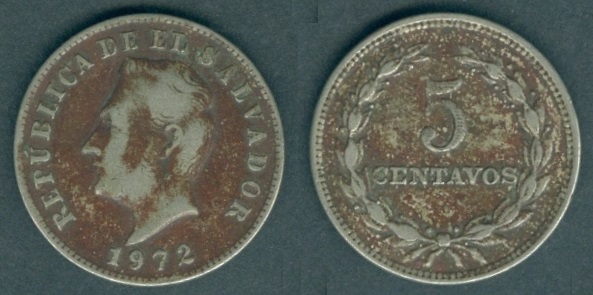 |
Same as above KM#134
5
Centavos,
but...
Year: 1972.
Weight: 4.86 g
[5.00g].
Mint:
San Francisco Mint, USA. Mintage:
10,000,000.
My coin is rusty due to much interaction with the environment. |
|
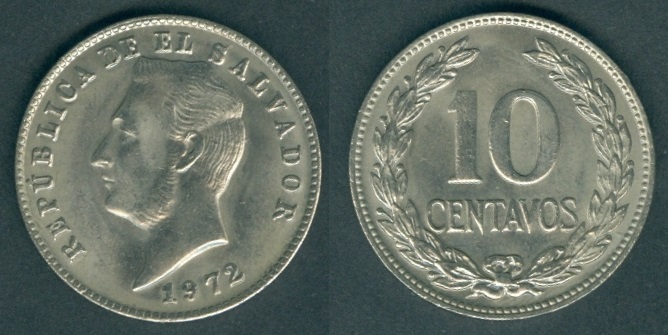 |
Same as above KM#130 10
Centavos,
but...
Year: 1972.
Weight: 7.14 g
[7.10g].
Mint:
San Francisco Mint, USA. Mintage:
7,000,000. |
|
| |
|
1974 |
| |
|
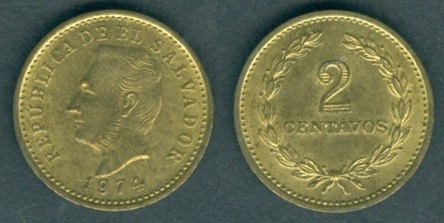 |
KM#147
2
Centavos. Year:
1974. Weight:
2.53g [2.60 g]. Metal:
Nickel-Brass.
Diameter:
16.90 mm. Edge:
Plain. Alignment:
Medal. Mint:
British Royal Mint, England. |
|
Obverse:
Francisco Morazán's head facing left in the
center. "REPÚBLICA DE EL
SALVADOR" (Republic of El Salvador) written in Spanish around
Francisco Morazán's
head. Date at the bottom.
Reverse:
Value "2 CENTAVOS" in the center,
surrounded by
wreath on both sides with wreath knot at the bottom.
Mintage:
10,004,000 +
4,000 Proof. Minted Years:
One year type.
Demonetized:
01 January 2001. |
|
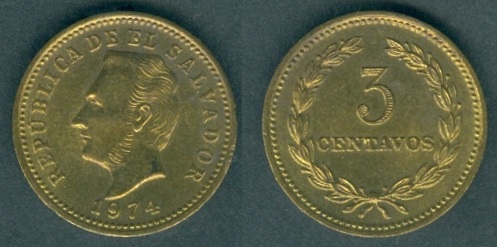 |
KM#148
3
Centavos. Year:
1974. Weight:
4.00g [4.00 g]. Metal:
Nickel-Brass.
Diameter:
19.00 mm. Edge:
Plain. Alignment:
Medal. Mint:
British Royal Mint, England. |
|
Obverse:
Francisco Morazán's head facing left in the
center. "REPÚBLICA DE EL
SALVADOR" (Republic of El Salvador) written in Spanish around
Francisco Morazán's
head. Date at the bottom.
Reverse:
Value "3 CENTAVOS" in the center,
surrounded by
wreath on both sides with wreath knot at the bottom.
Mintage:
10,002,000 +
2,000 Proof. Minted Years:
One year type.
Demonetized:
01 January 2001. |
|
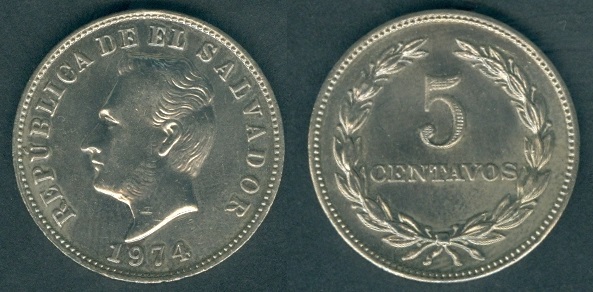 |
Same as above KM#134
5
Centavos,
but...
Year: 1974.
Weight: 5.08 g
[5.00g].
Mint:
Sherritt Mint, Fort Saskatchewan, Canada. Mintage:
10,002,000 + 2,000 Proofs. |
|
| |
|
1976 |
| |
|
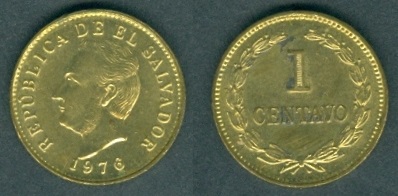 |
KM#135.2
Centavo. Year:
1976. Weight:
1.52g [1.50 g]. Metal:
Brass.
Diameter:
15.00 mm. Edge:
Plain. Alignment:
Medal. Mint:
Sherritt Mint, Fort Saskatchewan, Canada. |
|
Obverse:
Francisco Morazán's head facing left in the
center. "REPÚBLICA DE EL
SALVADOR" (Republic of El Salvador) written in Spanish around
Francisco Morazán's
head. Date at the bottom.
Reverse:
Value "1 CENTAVO" in the center,
surrounded by
wreath on both sides with wreath knot at the bottom.
Mintage:
20,000,000.
Minted Years:
1976 and 1977.
Demonetized:
01 January 2001. |
|
| |
|
1977 |
| |
|
 |
Same as above KM#135.2
Centavo,
but...
Year: 1977.
Weight: 1.51 g
[1.50g].
Mint:
Sherritt Mint, Fort
Saskatchewan, Canada.. Mintage:
40,000,000. |
|
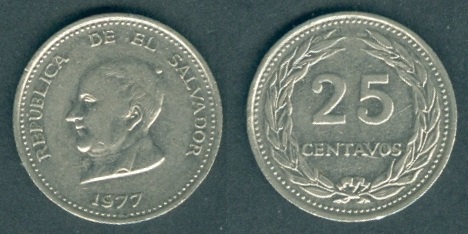 |
KM#139
25 centavos. Year:
1977. Weight:
2.49g [2.50 g]. Metal:
Nickel (magnetic).
Diameter:
17.80 mm. Edge:
Reeded. Alignment:
Coin. Mint:
British Royal Munt, England. |
|
Obverse:
José Matías Delgado's head facing left in the
center. "REPÚBLICA DE EL
SALVADOR" (Republic of El Salvador) written in Spanish around
José Matías Delgado's
head. Date at the bottom.
Reverse:
Value "25 CENTAVOS" in the center,
surrounded by
cross wreath on both sides.
Mintage:
22,400,000.
Minted Years:
1970
(British Royal Mint),
1973 (Sherritt Mint),
1975 (Sherritt Mint)
and 1999
(British Royal Mint).
Demonetized:
01 January 2001.
José Matías Delgado
y León (born: 24 February 1767, San Salvador – died: 12 November
1832, San Salvador) was a Salvadoran priest and doctor known as El
Padre de la Patria Salvadoreña (The Father of the Salvadoran
Fatherland). He was a leader in the independence
movement of El Salvador from the Spanish Empire, and from 28
November 1821 to 09 February 1823 when he was president of the
Central American constituent congress which met in Guatemala City
On 22 January 1833 the National Assembly declared him Benemérito de
la Patria.
When the Central American governmental junta voted to join the
Mexican Empire (05 January 1822), Delgado (and many other
Salvadorans) opposed this. On 11 January 1822 in San Salvador, the
city government, presided over by Padre Delgado, and many members of
the public protested the decision. Also on 11 January, the
government of El Salvador seceded from Guatemala in order to remain
outside the Mexican Empire.
In April 1822 Colonel Manuel Arzú, in command of Guatemalan troops,
occupied the Salvadoran cities of Santa Ana and Sonsonate. On 03
June 1822, Arzú entered San Salvador, reaching the Plaza Major. Nine
hours of fighting resulted in many casualties, burned houses and
plundering, but the Guatemalans then withdrew. Delgado's nephew,
Colonel Manuel José Arce, was one of the commanders of the
Salvadoran defenders. On 06 June 1822, Salvadoran troops reoccupied
Santa Ana, and later also Ahuachapán and Sonsonate. On 02 December
1822, fearing further encroachment from Guatemala, El Salvador
officially asked for annexation to the United States. A delegation
was sent to the United States to negotiate. That same month,
Brigadier Vicente Filisola, Captain-General of Guatemala (within the
Mexican Empire), marched toward San Salvador. He entered the city on
09 February 1823, declaring respect for people and goods, but also
the annexation of the province to Mexico. This was the end of the
government of José Matías Delgado.
On the fall of Mexican Emperor Agustín de Iturbide in 1823, Central
America declared its independence. Delgado was elected one of the
representatives to the constituent congress of the Federal Republic
of Central America. This Congress met in Guatemala beginning on 24
June 1823, and Delgado was chosen to preside.
On 05 May 1824 he was named the first bishop of San Salvador by the
local civil authorities and not by the Catholic Church. This
entangled him in a serious and long-lasting controversy with the
Archbishop of Guatemala and the Vatican authorities that lasted
until his death.
In 1824 he bought in Guatemala, with public money, the first
official printing press in El Salvador. It was used to publish the
first Salvadoran newspaper, El Semanario Político Mercantil. The
first issue appeared on 31 July 1824.
Delgado died on 12 November 1832 in San Salvador. As his funeral
procession passed the Plaza Mayor, mourners showered his coffin with
white rose petals. His remains are interred at El Rosario Church. |
|
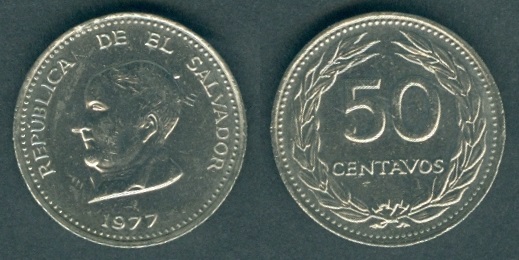 |
KM#140.2
50 centavos. Year:
1977. Weight:
4.99g [5.00 g]. Metal:
Nickel (magnetic).
Diameter:
20.00 mm. Edge:
Reeded. Alignment:
Coin. Mint:
British Royal Munt, England. |
|
Obverse:
José Matías Delgado's head facing left in the
center. "REPÚBLICA DE EL
SALVADOR" (Republic of El Salvador) written in Spanish around
José Matías Delgado's
head. Date at the bottom.
Reverse:
Value "50 CENTAVOS" in the center,
surrounded by
cross wreath on both sides.
Mintage:
1,500,000.
Minted Years:
1970
(KM#140.1 British Royal Mint; Weight:
3.90 g, Thickness: 1.65 mm)
and 1977
(KM#140.2 British Royal Mint; Weight:
5.00 g, Thickness: 2.00 mm).
Demonetized:
01 January 2001. |
|
| |
|
1981 |
| |
|
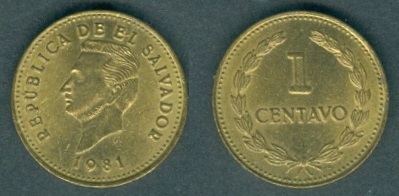 |
KM#135.2a
Centavo. Year:
1981. Weight:
1.51g [1.50 g]. Metal:
Brass.
Diameter:
15.00 mm. Edge:
Plain. Alignment:
Medal. Mint:
Guatemala City Mint, Guatemala. |
|
Obverse:
Francisco Morazán's head facing left in the
center. "REPÚBLICA DE EL
SALVADOR" (Republic of El Salvador) written in Spanish around
Francisco Morazán's
head. Engraver's initials DH under
bust. Date at the bottom.
Reverse:
Value "1 CENTAVO" in the center,
surrounded by
wreath on both sides with wreath knot at the bottom.
Mintage:
50,000,000.
Minted Years:
One year type.
Designer:
Mirsa Soto (Reverse side / Value side).
Demonetized:
01 January 2001. |
|
| |
|
1985 |
| |
|
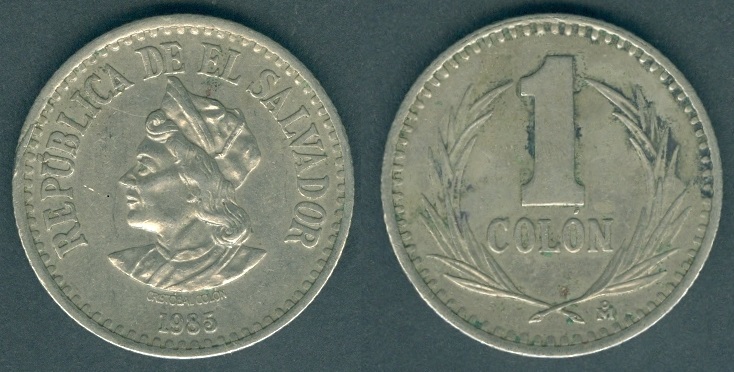 |
|
KM#153
Colón. Year:
1985. Weight:
9.42g [9.50 g]. Metal:
Copper-Nickel.
Diameter:
29.00 mm. Edge:
Reeded. Alignment:
Coin. Mint:
Casa de Moneda de Mexico (Mexico City, Mexico).
Obverse:
Christopher Columbus's head facing left in the
center with "CRISTÓBAL COLÓN" (Christopher Columbus) written in
Spanish below it. "REPÚBLICA DE EL SALVADOR" (Republic of El
Salvador) written in Spanish around Christopher Columbus's head. Date at the bottom.
Reverse:
Value "1 COLÓN" in the center,
surrounded by
wreath on both sides with wreath knot at the bottom. Mintmark "Mo"
written at the bottom right side.
Mintage:
20,000,000.
Minted Years:
1984
(Casa de Moneda de Mexico)
and 1985
(Casa de Moneda de Mexico).
Demonetized:
01 January 2001.
Christopher Columbus
(Latin: Christophorus Columbus; Ligurian: Cristoffa Corombo;
Italian: Cristoforo Colombo; Spanish: Cristóbal Colón; born: between
25 August and 31 October 1451 – died: 20 May 1506) was an Italian
explorer and navigator who completed four voyages across the
Atlantic Ocean, opening the way for European exploration and
colonization of the Americas. His expeditions, sponsored by the
Catholic Monarchs of Spain, were the first European contact with the
Caribbean, Central America, and South America. |
|
| |
|
1988 |
| |
|
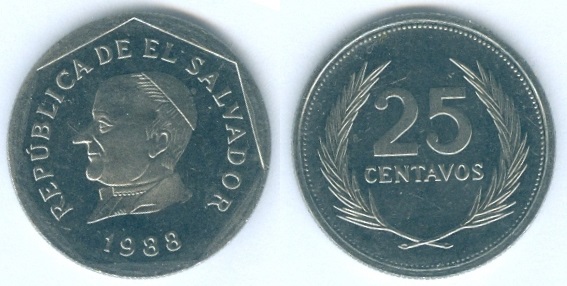 |
KM#157
25 centavos. Year:
1988. Weight:
4.03g [4.00 g]. Metal:
Stainless Steel (magnetic).
Diameter:
22.50 mm. Edge:
Reeded. Alignment:
Medal. Mint:
Vereingte Deutsche Metall, Germany. |
|
Obverse:
José Matías Delgado's head facing left in the
center. "REPÚBLICA DE EL
SALVADOR" (Republic of El Salvador) written in Spanish around
José Matías Delgado's
head. Date at the bottom. All details
within inner heptagon.
Reverse:
Value "25 CENTAVOS" in the center,
surrounded by
cross wreath on both sides.
Mintage:
20,000,000 + N/A proofs.
Minted Years:
1988
(Normal and Proof by Vereingte Deutsche
Metall, Germany)
and 2000
(Royal Canadian Mint, Canada).
Demonetized:
01 January 2001.
Note:
Below are other dates, produced by
various mints:
- KM#157a
exists in
Copper-Nickel clad Steel, weight:
4.00 g, Diameter: 23.00 mm. They were produced by Vereingte
Deutsche Metall in 1992 and
1995.
- KM#157b
exists in
Nickel clad Steel, weight: 4.00 g,
Diameter: 22.50 mm. They were produced by
1993 (British Royal Mint), 1994
(Sherritt Mint, Fort Saskatchewan, Canada),
1998 (Royal Mint of Belgium) and
1999 (Royal Mint of Belgium).
|
|
| |
|
1989 |
| |
|
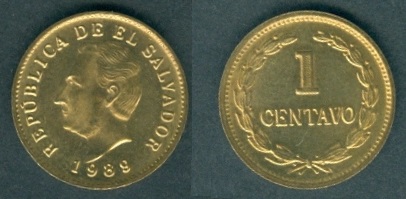 |
KM#135.1a
Centavo. Year:
1989. Weight:
1.37g [1.35 g]. Metal:
Bronze clad Steel (magnetic).
Diameter:
15.00 mm. Edge:
Plain. Alignment:
Medal. Mint:
Vereingte Deutsche Metall,
Germany. |
|
Obverse:
Francisco Morazán's head facing left in the
center. "REPÚBLICA DE EL
SALVADOR" (Republic of El Salvador) written in Spanish around
Francisco Morazán's
head. Date at the bottom.
Reverse:
Value "1 CENTAVO" in the center,
surrounded by
wreath on both sides with wreath knot at the bottom.
Mintage:
36,000,000.
Minted Years:
1989 and 1992.
Demonetized:
01 January 2001. |
|
| |
|
1991 |
| |
|
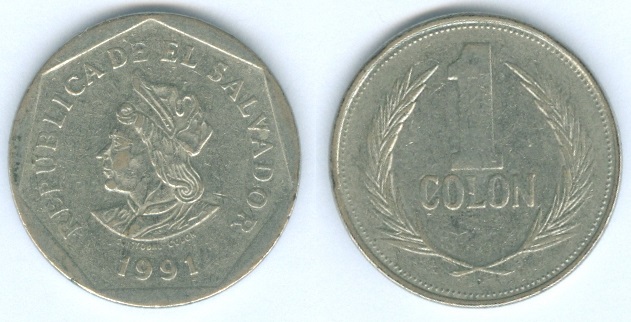 |
KM#156a
Colón. Year:
1991. Weight:
6.02g [6.00 g]. Metal:
Copper-Nickel clad Steel (magnetic).
Diameter:
25.00 mm. Edge:
Reeded. Alignment:
Coin. Mint:
Vereingte Deutsche Metall, Germany. |
|
Obverse:
Christopher Columbus's head facing left in the
center with "CRISTÓBAL COLÓN" (Christopher Columbus) written in
Spanish below it. "REPÚBLICA DE EL SALVADOR" (Republic of El
Salvador) written in Spanish around Christopher Columbus's head. Date at the bottom.
All details within inner
heptagon.
Reverse:
Value "1 COLÓN" in the center,
surrounded by
wreath on both sides with wreath knot at the bottom.
Mintage:
N/A.
Minted Years:
One year type.
Demonetized:
01 January 2001. |
|
| |
|
1992 |
| |
|
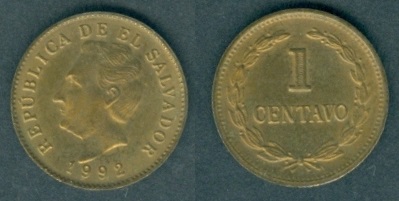 |
Same as above KM#135.1a
Centavo,
but...
Year: 1992.
Weight: 1.36 g
[1.35g]. Metal:
Bronze clad Steel (magnetic).
Mint:
Vereingte Deutsche Metall,
Germany. Mintage:
N/A. |
|
| |
|
1993 |
| |
|
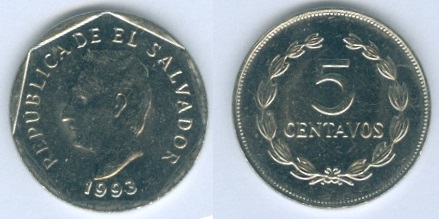 |
KM#154b
5 centavos. Year:
1993. Weight:
1.99g [2.00 g]. Metal:
Stainless Steel (magnetic).
Diameter:
17.00 mm. Edge:
Plain. Alignment:
Medal. Mint:
Sherritt Mint, Fort Saskatchewan, Canada. |
|
Obverse:
Francisco Morazán's head facing left in the
center. "REPÚBLICA DE EL
SALVADOR" (Republic of El Salvador) written in Spanish around
Francisco Morazán's
head. Date at the bottom. All details
within inner heptagon.
Reverse:
Value "5 CENTAVOS" in the center,
surrounded by
wreath on both sides with wreath knot at the bottom.
Mintage:
N/A.
Minted Years:
1992
(Sherrit Mint), 1993
(Sherrit Mint), 1994
(Vereingte Deutsche Metall), 1995
(Sherrit Mint), 1998
(Royal Mint of Belgium) and 1999 (Royal
Mint of Belgium).
Demonetized:
01 January 2001. |
|
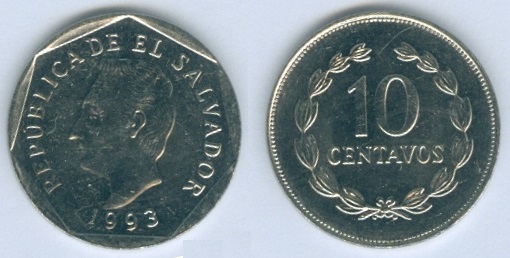 |
KM#155a
10 centavos. Year:
1993. Weight:
2.98g [3.00 g]. Metal:
Nickel clad Steel (magnetic).
Diameter:
20.00 mm. Edge:
Plain. Alignment:
Medal. Mint:
Sherritt Mint, Fort Saskatchewan, Canada. |
|
Obverse:
Francisco Morazán's head facing left in the
center. "REPÚBLICA DE EL
SALVADOR" (Republic of El Salvador) written in Spanish around
Francisco Morazán's
head. Date at the bottom. All details
within inner heptagon.
Reverse:
Value "10 CENTAVOS" in the center,
surrounded by
wreath on both sides with wreath knot at the bottom.
Mintage:
N/A.
Minted Years:
1992
(British Royal Mint, England), 1993
(Sherrit Mint) and 1994 (Vereingte Deutsche Metall).
Demonetized:
01 January 2001. |
|
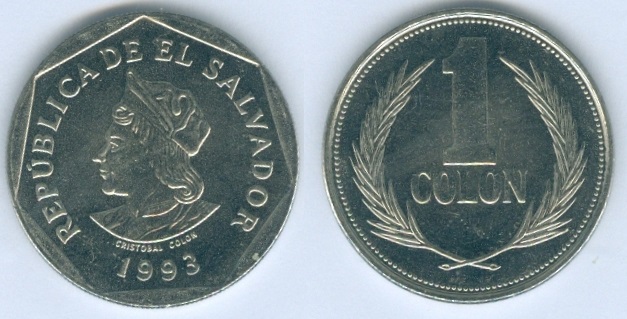 |
KM#156b
Colón. Year:
1993. Weight:
5.98g [6.00 g]. Metal:
Nickel clad Steel (magnetic).
Diameter:
25.00 mm. Edge:
Reeded. Alignment:
Coin. Mint:
British Royal Mint, England. |
|
Obverse:
Christopher Columbus's head facing left in the
center with "CRISTÓBAL COLÓN" (Christopher Columbus) written in
Spanish below it. "REPÚBLICA DE EL SALVADOR" (Republic of El
Salvador) written in Spanish around Christopher Columbus's head. Date at the bottom.
All details within inner
heptagon.
Reverse:
Value "1 COLÓN" in the center,
surrounded by
wreath on both sides with wreath knot at the bottom.
Mintage:
N/A.
Minted Years:
1993
(British Royal Mint, England)
1994
(Sherrit Mint, Canada), 1995
(Vereingte Deutsche Metall, Germany),
1998
(Royal Mint of Belgium)
and 1999
(Royal Mint of Belgium).
Demonetized:
01 January 2001. |
|
| |
|
1994 |
| |
|
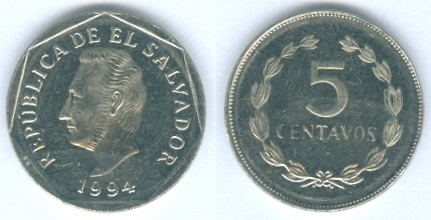 |
Same as above KM#154b 5
Centavos,
but...
Year: 1994.
Weight: 2.02 g
[2.00g].
Mint:
Vereingte Deutsche Metall,
Germany. Mintage:
N/A + N/A Proof. |
|
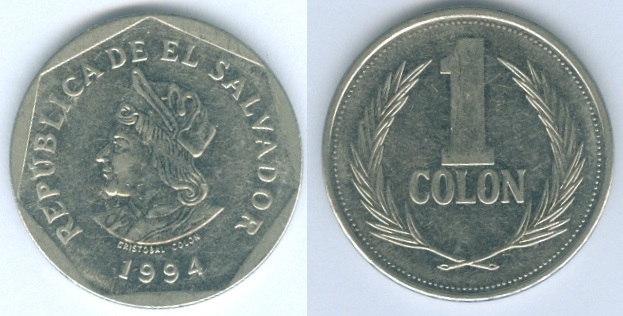 |
Same as above KM#156b Colón,
but...
Year: 1994.
Weight: 5.92 g
[6.00g].
Mint:
Sherritt Mint, Fort Saskatchewan, Canada. Mintage:
N/A. |
|
| |
|
1995 |
| |
|
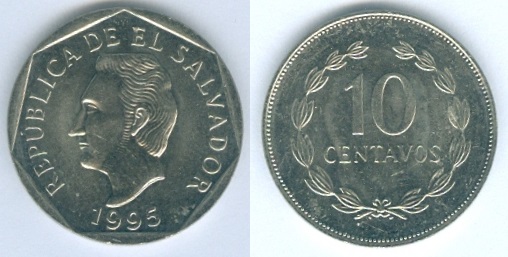 |
KM#155b
10 centavos. Year:
1995. Weight:
3.01g [3.00 g]. Metal:
Copper-Nickel clad Steel (magnetic).
Diameter:
20.00 mm. Edge:
Plain. Alignment:
Medal. Mint:
Deutsche Nickel A.G., Germany. |
|
Obverse:
Francisco Morazán's head facing left in the
center. "REPÚBLICA DE EL
SALVADOR" (Republic of El Salvador) written in Spanish around
Francisco Morazán's
head. Date at the bottom. All details
within inner heptagon.
Reverse:
Value "10 CENTAVOS" in the center,
surrounded by
wreath on both sides with wreath knot at the bottom.
Mintage:
N/A.
Minted Years:
1995
(Deutsche Nickel A.G., Germany), 1998
(Royal Mint of Belgium) and
1999 (Royal Mint of Belgium).
Demonetized:
01 January 2001. |
|
| |
| |
| Currency:
U.S. Dollar (USD) = 100 cents. [2001-Date] |
| For USA coins, refer to my separate
listings of Unites States of America
webpages. |
| |
| |
| |
|
|
| Countries
/ Territories |
| |
|
Chiefa Coins | |
|




































